(Translated from the original article on February 10, 2024)
Hello, this is KA-TSU.
It is already February, and I would like to talk about the time around the winter solstice.
If you want to capture the longest star trails possible, the “winter solstice,” which has the shortest daytime (i.e., longest nighttime) in the northern hemisphere, probably comes to mind. In Yokohama, where I live, it should be possible to photograph star trails longer than 12 hours around the winter solstice. So I tried, and the results are below.
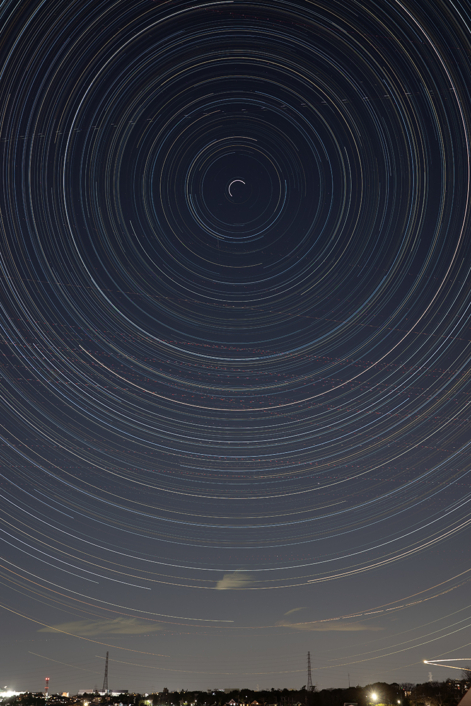
This example is the result of interval compositing with the GR IIIx in manual exposure mode, f/4.0, 4-second exposure, ISO 400, from 17:30 on December 21, 2023, for 12 hours and 20 minutes of shooting time.
White balance was set to auto and colors were adjusted by RAW development. The low-pass filter was set to high for the stars.
For most urban shots, the exposure settings shown in the example above should be just right. To make it easy for everyone to try, I used the easy-to-remember "4, 4, 4" setting.
The GR III/GR IIIx can operate for a long time when powered by a PD-compatible (5V, 3A output) portable battery. In this shooting, the use of a 10000 mAh battery, which is common these days, made it possible to shoot for over 12 hours.
I wanted to use an easy method where I could leave the camera alone and sleep and wait, so the location was a balcony overlooking the north side of my house. I set the "Save Interim Images" setting to "Blended" so that I could capture earlier data even if it was interrupted by unintentional clouds, and used a 256GB SD card (for reference, there were 9812 shots including RAW in this shoot, which is about 110GB of data. Depending on the landscape, 128 GB may not be enough).
After several unsuccessful attempts, I happened to succeed on the night before the winter solstice.
https://supercweather.com/
Even though the Kanto area has a high percentage of clear skies in December, there must have been only a few nights when there were hardly any clouds throughout the night.
Although the forecast was accurate for the first few hours of shooting, six hours later there were many small clouds crossing the sky and cloud trails all over the place. ......... You never know until you try.
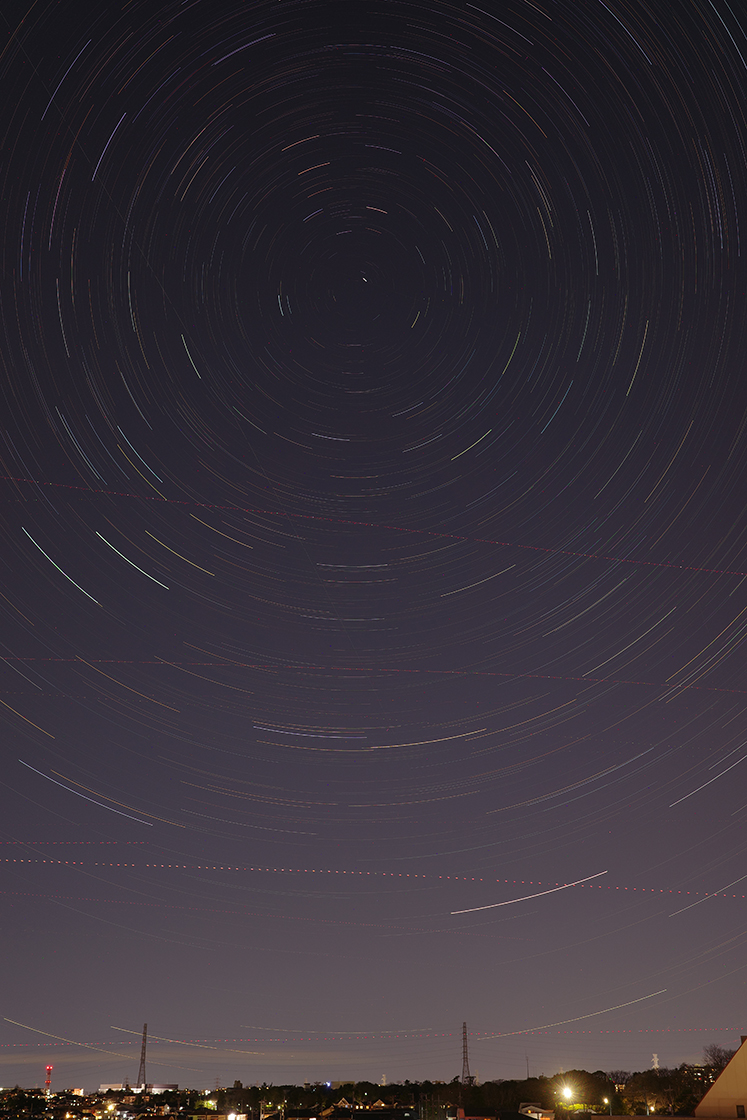
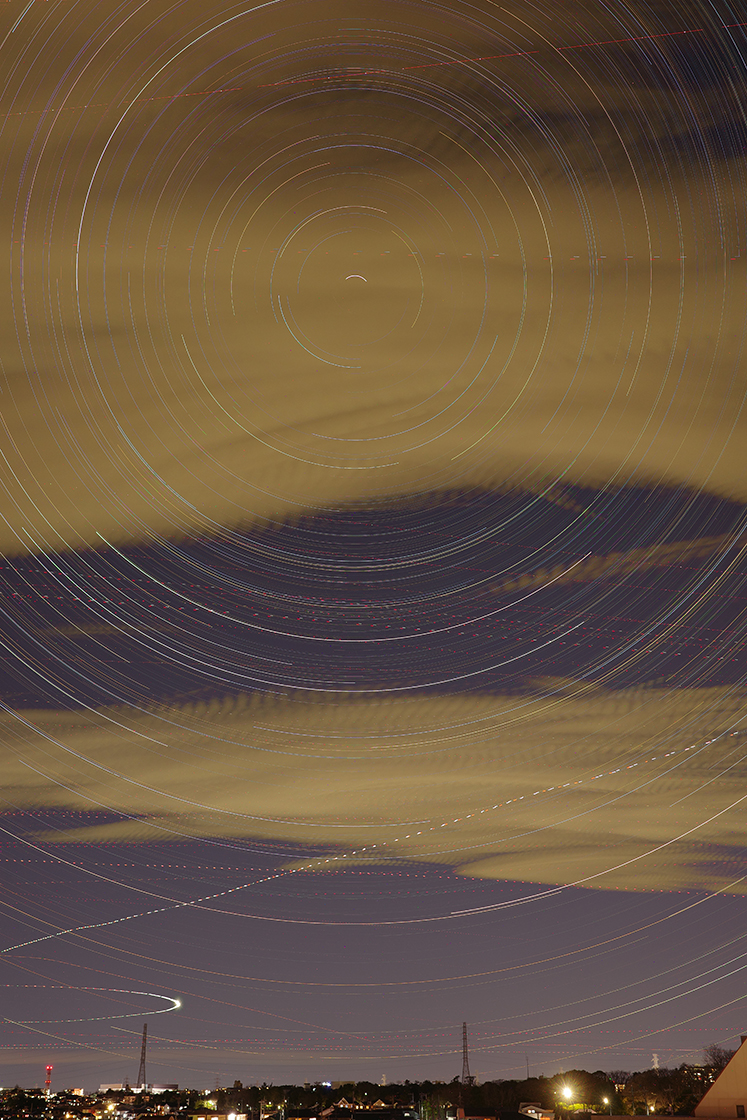
You might notice something else when you look at these pictures.
In the first image (taken after one hour), Polaris is roughly in the center of the screen, so it is hard to notice, but in the second image (taken six hours later), the center of rotation is clearly shifted to the left.
In order to adjust the center of rotation to the intended position, it would be better to take at least one long shot to determine the composition (in fact, this shot was taken to determine the detailed composition before the actual shooting, even though the weather was going to be a bit bad).
This time, I was lucky enough to be able to get 12 hours and 20 minutes of light trails with such an easy method. To know more precisely, I checked how long we have a chance to get more than 12 hours of light trails (in Yokohama).
Using the following website, I made a graph of “time between sunset and sunrise”, “time of sunrise”, and “time of sunset” around the winter solstice as follows.
https://keisan.casio.jp/exec/system/1236677229
I used the data from "Yokohama no Koyomi" published by the National Astronomical Observatory of Japan, calculated at 139.6500 longitude, 35.4500 latitude, and 0 m elevation (I did not use the information from the National Astronomical Observatory of Japan because it does not indicate in seconds). The winter solstice is marked in yellow, the earliest sunset in blue, and the latest sunrise in red.
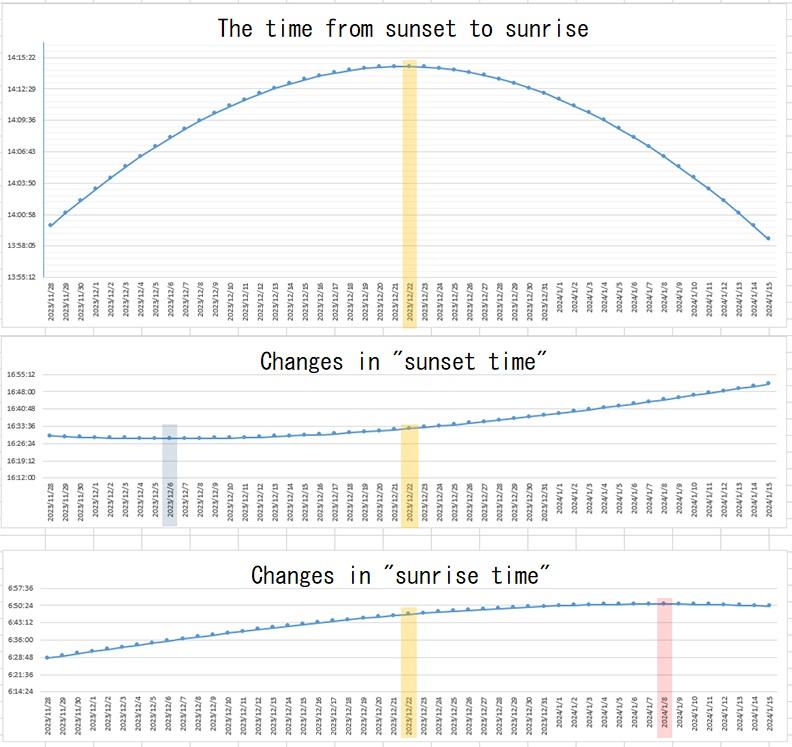
Considering that there is “in-between light" (i.e. twilight) for about an hour after sunset and about an hour before sunrise, we can expect 12 hours of light trace in Yokohama for a period of about three weeks before and after the winter solstice. The further away from the winter solstice, the harder the start and end times are, so the best time is around the winter solstice.
As for the “in-between light,” you won't know until you actually take the pictures because you don't know how much light will be coming from the city.
As for the start of shooting, you can start interval compositing when the brightness settles down while taking test shots, but it is difficult to determine the end of shooting.
When I took pictures from the night of the winter solstice to the next morning to see how the brightness of the in-between light changes, I found the following boundary lines.
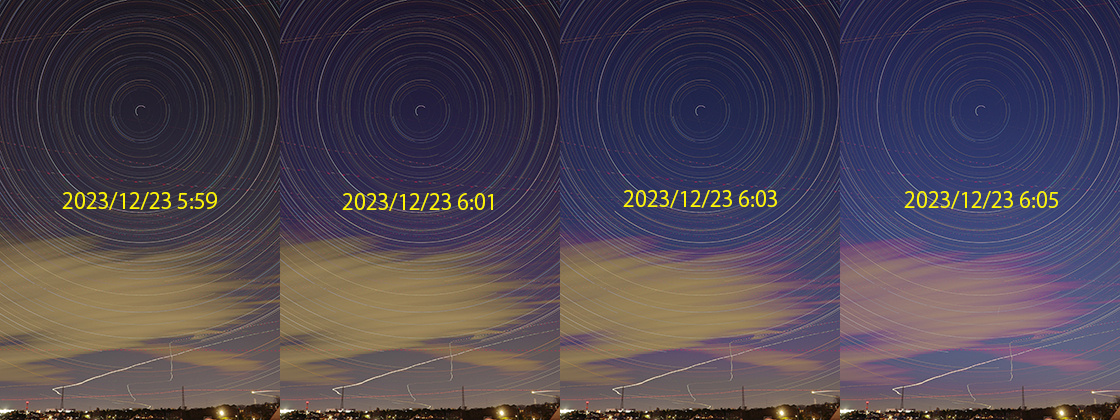
As you can see in the far left photo at 5:59, the sky remained dark until that time. The rest shows how quickly the sky brightens after that. Just two minutes makes a big difference.
Interval compositing has a trick called "Save Interim Images," which allows you to take a JPEG of the sky just before it starts to brighten. However, if you want to shoot in RAW for as long as possible, more detailed calculations and experimentation are required.
In this successful case, I was able to record 12 hours and 20 minutes of light trails, but it seems that it can be extended by another 10 minutes or so.
That's all for my article on the information from the easy method to more detailed preliminary studies.
If you are interested in the "Longest Light Trail Photo Challenge", please try it at the end of the year or the beginning of the new year.
(KA-TSU)














